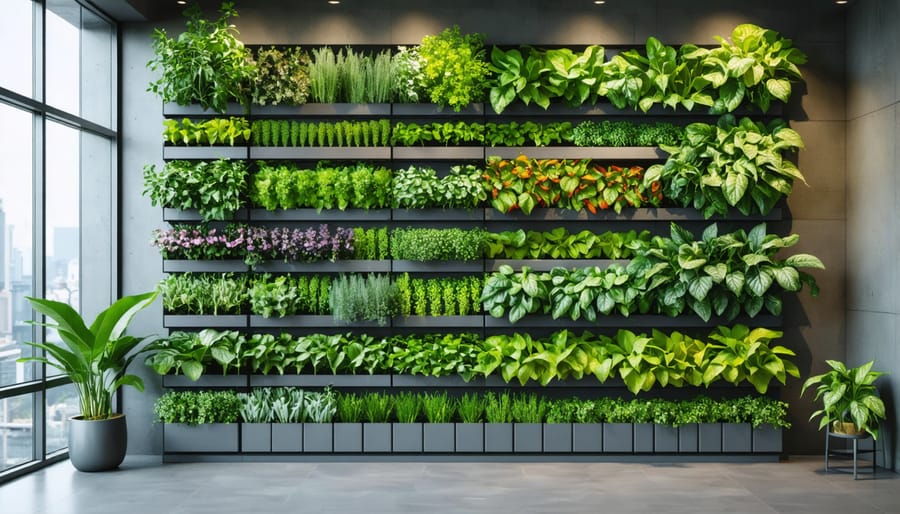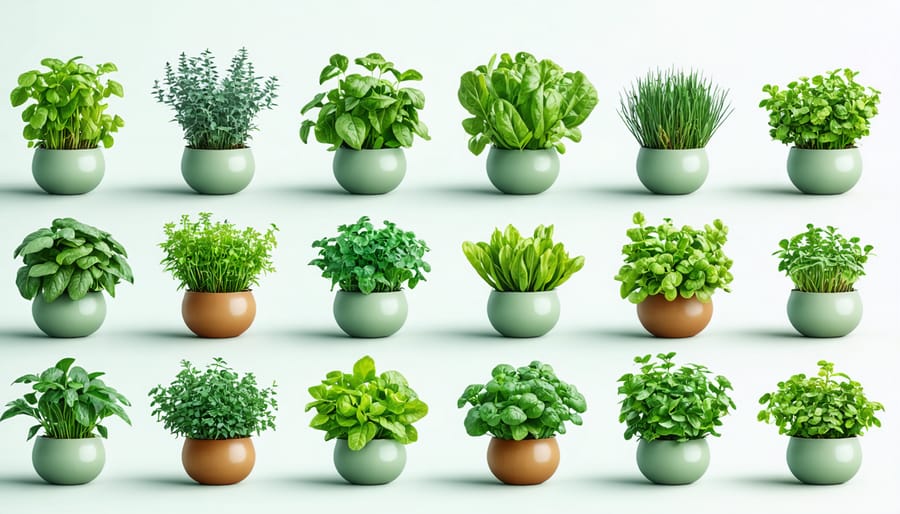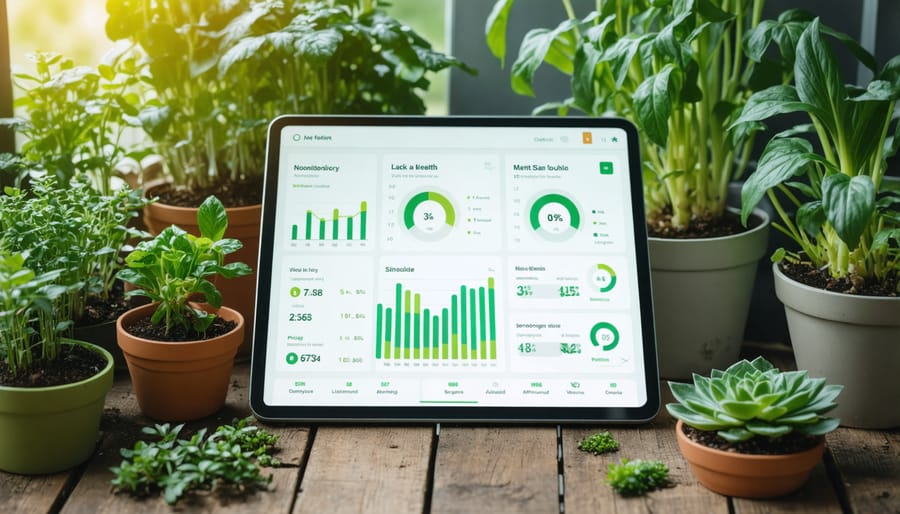Transform any corner of your home into a thriving, sustainable ecosystem with an indoor garden that nurtures both your well-being and the environment. Modern indoor gardening seamlessly blends smart technology with age-old growing techniques, creating self-sustaining green spaces that flourish year-round while minimizing resource consumption. From compact hydroponic systems that fit under kitchen cabinets to vertical gardens that turn blank walls into living masterpieces, sustainable indoor gardens represent the perfect fusion of innovation and environmental consciousness.
Today’s indoor gardeners are revolutionizing traditional growing methods by incorporating water-recycling systems, LED grow lights powered by renewable energy, and smart sensors that optimize plant care while reducing waste. Whether you’re a seasoned plant enthusiast or just beginning your green journey, creating an indoor sustainable garden offers a practical solution to growing fresh produce, purifying your air, and contributing to a more sustainable future—all from the comfort of your home.
This comprehensive guide will walk you through everything you need to know about establishing and maintaining an indoor garden that’s both environmentally responsible and surprisingly low-maintenance, proving that sustainable living doesn’t require sacrificing style or convenience.
Why Your Home Needs a Sustainable Indoor Garden
Environmental Impact Made Simple
Growing your own food indoors isn’t just a trendy hobby – it’s a powerful way to reduce your environmental footprint. When you cultivate herbs, vegetables, and greens at home, you’re cutting down on food miles – the distance your produce travels from farm to table. Think about it: the average vegetable in the U.S. travels about 1,500 miles before reaching your plate! Your indoor garden eliminates those transportation emissions entirely.
But the benefits don’t stop there. Indoor gardens help reduce packaging waste since there’s no need for plastic wrapping or containers. You’re also saving water compared to traditional farming methods, as indoor gardening typically uses 90% less water through efficient irrigation systems and controlled environments.
By growing your own food, you’re also supporting biodiversity right from your living room. You can choose to grow heirloom varieties that might not be available in stores, and you have complete control over avoiding harmful pesticides and chemicals. Plus, indoor plants naturally purify your air by absorbing CO2 and releasing oxygen, creating a healthier home environment while fighting climate change in their own small way.
The Real Cost Benefits
Creating an indoor sustainable garden isn’t just good for the environment – it’s great for your wallet too! Let’s break down the numbers: a typical family of four spends around $1,000 annually on fresh produce. By growing just 25% of your vegetables and herbs indoors, you could save $250-300 per year on grocery bills.
The savings don’t stop at the produce aisle. Indoor gardens can help regulate your home’s humidity levels naturally, potentially reducing your heating and cooling costs by 5-10%. This translates to approximately $100-150 in annual energy savings, depending on your location and climate.
Fresh herbs are particularly cost-effective to grow. A small pot of basil costs about $3-4 to start but can yield $30-40 worth of fresh herbs over its lifetime. Growing common vegetables like lettuce, cherry tomatoes, and microgreens can slash your produce expenses by 30-40% for these items.
Remember, while there are initial setup costs, most indoor gardeners break even within the first year, making it a smart long-term investment for both your home and budget.
Setting Up Your Smart Indoor Garden
Space-Smart Solutions
Don’t let limited space hold you back from creating your dream indoor garden! With modern space-saving solutions, even the coziest apartments can transform into lush green havens.
Vertical gardening is your best friend when maximizing square footage. Install wall-mounted planters or create a living wall system using pocket planters. These systems not only save floor space but also create stunning visual impact. Try mounting lightweight gutters horizontally on your walls to grow herbs and microgreens, or repurpose a wooden pallet into a vertical garden after waterproofing it.
Multi-tier systems offer another brilliant solution. Consider investing in stackable planters or building a DIY plant ladder. Window-mounted shelving units can turn unused window space into a thriving herb garden, while hanging planters from the ceiling adds dimension without sacrificing precious floor area.
For corner spaces, try triangular tower gardens or spiral plant stands that maximize growing space while maintaining a small footprint. Utilize areas above cabinets or refrigerators with trailing plants in self-watering containers. Remember to choose plants that thrive in your specific light conditions – not every corner needs direct sunlight for success.
Think creatively about dual-purpose furniture: place plants on rolling carts that can move easily, or integrate them into room dividers. This approach ensures your garden remains flexible and adaptable to your changing needs while maintaining its sustainability focus.

Essential Smart Tech
Smart technology has revolutionized indoor gardening, making it easier than ever to maintain a thriving sustainable garden. At the heart of any modern setup is an automated watering system, which delivers precise amounts of water to your plants exactly when they need it. These systems range from simple self-watering containers to sophisticated drip irrigation setups with moisture sensors that take the guesswork out of watering schedules.
LED grow lights have become a game-changer for indoor gardeners, offering energy-efficient lighting that mimics natural sunlight. These lights consume up to 75% less energy than traditional growing lamps while producing minimal heat. Many modern LED systems come with adjustable spectrums and scheduling features, allowing you to customize the light cycle for different growing stages.
Smart monitoring tools are your eyes and ears when you’re away from your garden. Wi-Fi-enabled sensors can track soil moisture, temperature, humidity, and light levels, sending real-time updates to your smartphone. Some advanced systems even integrate with virtual assistants, allowing you to check on your garden with a simple voice command.
To maximize efficiency, consider combining these technologies into a single ecosystem. For example, connect your moisture sensors to your watering system and synchronize your grow lights with natural daylight patterns. This integration not only saves resources but also creates optimal growing conditions while reducing your environmental footprint.
Sustainable Materials and Methods
Creating a sustainable indoor garden starts with choosing the right materials. Opt for recycled or upcycled containers – from mason jars to repurposed wooden crates – which not only contribute to eco-friendly home decor but also add character to your space. When selecting beautiful plant pots, look for options made from biodegradable materials like bamboo, cork, or recycled plastic.
For soil, consider creating your own mix using compost and organic matter. A quality organic potting mix combined with homemade compost provides nutrients while reducing waste. Incorporate water-retention crystals or coconut coir to minimize water usage and maintain optimal moisture levels.
Implement sustainable growing practices by starting a small composting system for kitchen scraps, which can later nourish your plants. Use natural pest control methods like neem oil or introducing beneficial insects rather than chemical pesticides. Capture rainwater or reuse greywater from your home for irrigation when possible.
Choose renewable materials for plant supports, such as bamboo stakes or twine made from natural fibers. LED grow lights, while initially more expensive, consume less energy and last longer than traditional lighting options. Remember to save seeds from your plants and start a seed library to reduce dependency on store-bought seedlings.
Plant Selection for Success
Best Low-Maintenance Edibles
Starting your indoor garden journey doesn’t have to be complicated. Here are some of the easiest edibles that thrive indoors and require minimal attention – perfect for busy households or beginners learning to style indoor plants.
Herbs lead the pack in low-maintenance options. Basil thrives in sunny windowsills and provides fresh leaves year-round with just weekly watering. Mint is another foolproof choice – it grows vigorously even in partial shade and adds fresh flavor to drinks and dishes. Chives are particularly resilient and regrow quickly after harvesting.
For vegetables, microgreens are your best bet. They grow quickly (ready in 7-14 days), need minimal space, and provide nutrient-dense additions to meals. Cherry tomatoes, especially dwarf varieties, perform well indoors with consistent sunlight and basic care. Leafy greens like spinach and lettuce are also excellent choices, requiring only moderate light and regular watering.
Don’t overlook sprouts – they’re probably the easiest edibles to grow indoors. Alfalfa, mung beans, and radish sprouts need only water and a jar to flourish, producing nutritious results within days. For those with bright windows, compact peppers like Thai chilies are surprisingly cooperative indoor plants that add both ornamental value and spice to your space.
Remember, these plants aren’t just easy to maintain – they’re also sustainable choices that reduce grocery trips and packaging waste while providing fresh, organic produce right at your fingertips.

Year-Round Growing Calendar
Growing your own food indoors doesn’t have to be limited by seasons. With proper planning, you can enjoy fresh harvests throughout the year. Here’s your month-by-month guide to keeping your indoor garden productive:
Winter (December-February)
Start your winter with microgreens and herbs like basil, mint, and parsley. These quick-growing plants thrive under grow lights when natural light is limited. Late winter is perfect for starting tomato and pepper seedlings for spring.
Spring (March-May)
As daylight increases, expand your growing space with leafy greens like lettuce, spinach, and kale. March is ideal for starting climbing plants like pole beans and peas in vertical gardens. Don’t forget to start your summer crops indoors now.
Summer (June-August)
Focus on heat-loving plants like cherry tomatoes and compact peppers. Keep herbs producing by regular harvesting and pruning. Start planning and seeding your fall crops in late summer to ensure continuous harvests.
Fall (September-November)
Return to cooler-season crops like Swiss chard and arugula. Start new batches of microgreens every two weeks for constant supply. Plant garlic and shallots in containers for winter harvests.
Pro Tip: Keep a garden journal to track planting dates and successes. Rotate your crops between different areas of your growing space to maintain soil health and prevent pest problems. Remember to adjust watering and lighting as seasonal natural light changes.
Maintenance Made Easy

Smart Monitoring Systems
Modern technology has made indoor gardening smarter and more efficient than ever. Smart monitoring systems act as your garden’s personal assistant, helping maintain the perfect environment for your plants to thrive. These clever devices track essential factors like soil moisture, light levels, temperature, and humidity in real-time, taking the guesswork out of plant care.
Many smart garden monitors connect to your smartphone through user-friendly apps, sending alerts when your plants need attention. For example, you’ll receive notifications if your herbs need watering or if your leafy greens aren’t getting enough light. Some advanced systems even integrate with smart home devices, automatically adjusting grow lights or activating small fans to maintain optimal conditions.
Setting up these monitoring systems is surprisingly simple. Most sensors stake directly into the soil or attach to nearby surfaces, and they typically run on batteries or USB power. While not essential for success, these smart tools can significantly improve your garden’s health and productivity while reducing water waste and energy consumption. They’re particularly helpful for busy plant parents who want to ensure their indoor garden stays sustainable and thriving.
Water and Energy Conservation
Creating a sustainable indoor garden means being mindful of your water and energy consumption. Start by installing a smart irrigation system with moisture sensors to water plants only when needed. These systems can reduce water usage by up to 50% compared to manual watering. Consider collecting rainwater or reusing greywater from your home for irrigation.
For lighting, opt for energy-efficient LED grow lights, which consume up to 75% less electricity than traditional growing lamps while lasting much longer. Position your garden near natural light sources to minimize artificial lighting needs. Use timers to ensure lights operate only during optimal growing hours.
Install reflective surfaces around your garden to maximize light distribution and reduce energy consumption. Consider using self-watering planters and water-retaining soil amendments like coconut coir or vermiculite to maintain moisture levels with less frequent watering.
Group plants with similar water needs together to prevent over or under-watering, and use mulch to reduce evaporation. Remember to regularly check and fix any leaks in your irrigation system to prevent water waste.
Creating a sustainable indoor garden is more than just a trend – it’s a meaningful step toward a greener, healthier lifestyle that starts right in your home. Throughout this guide, we’ve explored the essential elements of building and maintaining an eco-friendly indoor garden, from choosing the right plants and sustainable materials to implementing water-saving techniques and smart technology solutions.
Remember, your sustainable indoor garden journey doesn’t have to be perfect from day one. Start small with a few hardy plants, experiment with different growing methods, and gradually expand your garden as your confidence grows. The beauty of indoor gardening lies in its flexibility – you can adapt your setup to fit your space, lifestyle, and environmental goals.
By incorporating sustainable practices like composting, using LED grow lights, harvesting rainwater, and choosing organic growing methods, you’re not just creating a beautiful living space – you’re contributing to a more sustainable future. Whether you’re growing fresh herbs for your kitchen, purifying your air with indoor plants, or creating a peaceful green sanctuary, your indoor garden can make a real difference.
Take the first step today. Choose your growing space, select your first plants, and begin your adventure in sustainable indoor gardening. As your garden grows, so will your connection to nature and your impact on the environment. Happy gardening!
